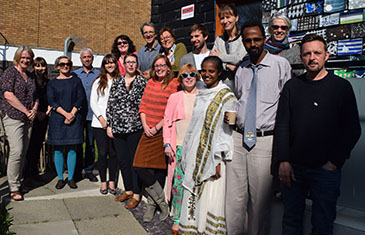Filling a CUPP – Starting Programmes of Community University Partnership

Written by Daniel Taylor,
Assistant Public Engagement Officer at the Centre for Public Engagement
This week I’ve had the privilege of being one of the first cohort on Developing Community-University Partnerships (C-UP) a course by the Community University Partnership Programme (CUPP) at Brighton University, dedicated to brokering community-university relationships, projects and partnerships. During the course we’ve discussed a wide range of topics but here I will begin at the start, with how programmes of community engagement can be set up.
Over the week we’ve explored this through exercises and presentations from university staff and community group members, leading to many discussions amongst the group. I’ve divided the creation strategies coming out of these into three rough categories, contract-driven, learning by doing and information gathering.
Contract Driven
Contract-driven methods involve either buying in external consultants or giving communities funds for ‘commissioning’ work from the university. These approaches suffered a hesitant response by the group for introducing power differentials and hierarchy into relationships, either in the shape of an ‘expert’ selected and hired by the university to act as a go-between, or in the act of commissioning, where the university is the ‘expert’ providing for (and not with) the community.
The case of hiring an external expert also highlighted the idiosyncrasies within C-UP working, questioning how much anyone can be an expert regarding a relationship based on such specificity, something that worked with one region, topic, etc, may not work in another.
However, there were examples around the room of local community leaders and activists coming in as consultants, indeed being part of the story of CUPP’s origins. These presented examples of how this approach can work, but it’s important to clearly set expectations at the start to prevent placing a community ‘anchor’ in a role that reduces the impact of their experience and knowledge in an unfamiliar working environment.
Learning by Doing
Learning by doing and setting up pilot projects based on small amounts of funding or support was widely regarded as the best starting point for C-UP programmes by both course members and the experienced speakers.
It can be extremely difficult to plan activities that you have never been part of before and anticipate all factors in advance. The experience of being part of projects provides central teams with new connections and experience, and evaluations from seed projects provide valuable pointers for others from those who have already walked similar paths. This may mean that initial projects risk being slow and making mistakes, but the learning and experience from these can be built on to improve future work, shape support and make vital links.
This importance was highlighted by presentations from founders of community based MA and undergraduate modules, with Dr Alice Fox, course leader of MA Inclusive Arts Practice telling us to find a small scale project and build your way from there, it’s about showing you can do things.
The application and selection process is vital to maximise positive effects of this approach. Selecting projects that you already know can save time but might not be the best projects to pilot. There might be, and probably are, other projects that you don’t know about, opening the application process up also raises awareness of your programme gathers information on existing and potential projects across the community and university.
Information Gathering
Building on this point I’ve left information gathering until last, as we all agreed this is important for discovering the services’ remit and creating a knowledge base, preventing inefficiencies, repetition and missed opportunities. However, it is difficult to collect information in isolation, so as stated above, the group was again in wide agreement that ‘learning by doing’ can collect information by inviting applications and carrying out projects. Rather than simply a step in the process information gathering must be a constant process woven in to programmes to remain accurate, being built on as information comes to light and new work is started.
Conclusion
So perhaps there is no one best approach to be pursued in isolation of all others. While pilots were widely adopted here, both teams agreed that auditing should be interwoven with this, and around the table former community group members working effectively as university advisors were proof that this experience can be invaluable when done well. The benefits of commissioning work were also discussed as an important step in other contexts and I am sure there are many other examples of how these programmes have started across the UK and wider.
However, the key thing I’ll personally take away from the course is to define C-UP programmes in the doing, ‘mucking in’ together can be the best way to test waters and to bring people and practice together.
By Daniel Taylor
Assistant Public Engagement Officer
Queen Mary University of London
(with editing by course attendees Dr Sally Hayes, Head of School of Health and Wellbeing at Leeds Beckett University and Dawn Smith, Community Engagement Developer at University of Edinburgh)